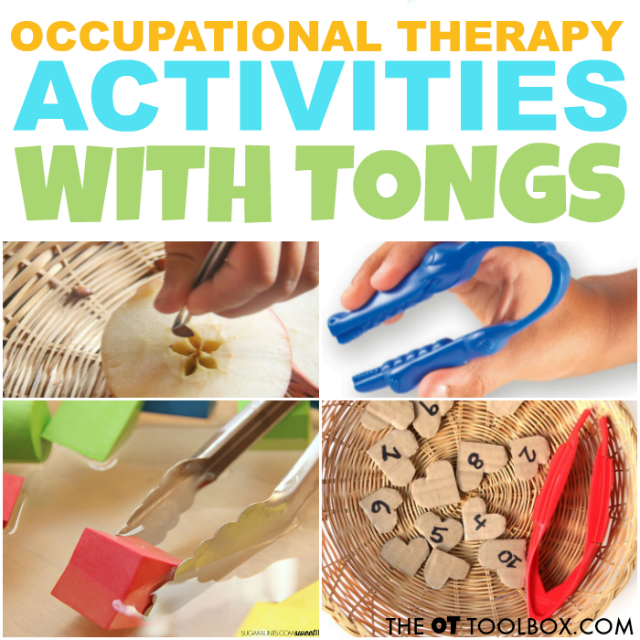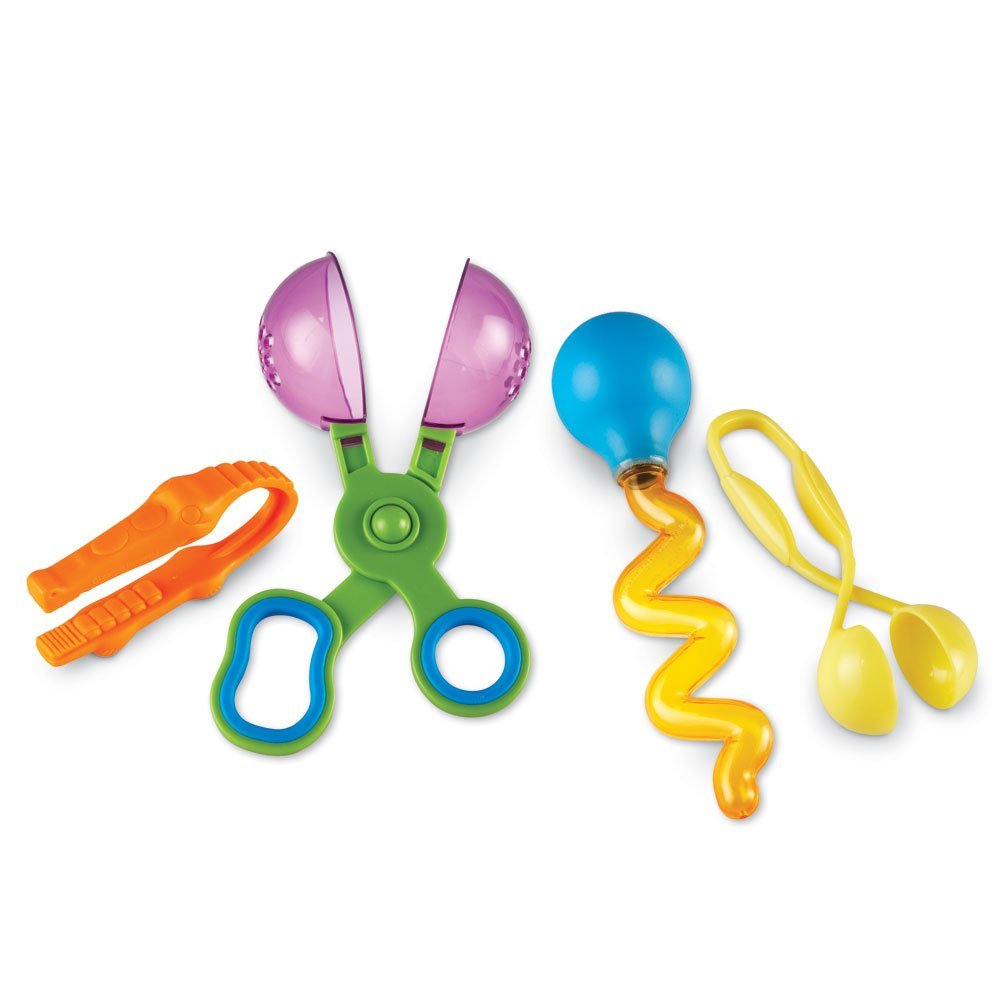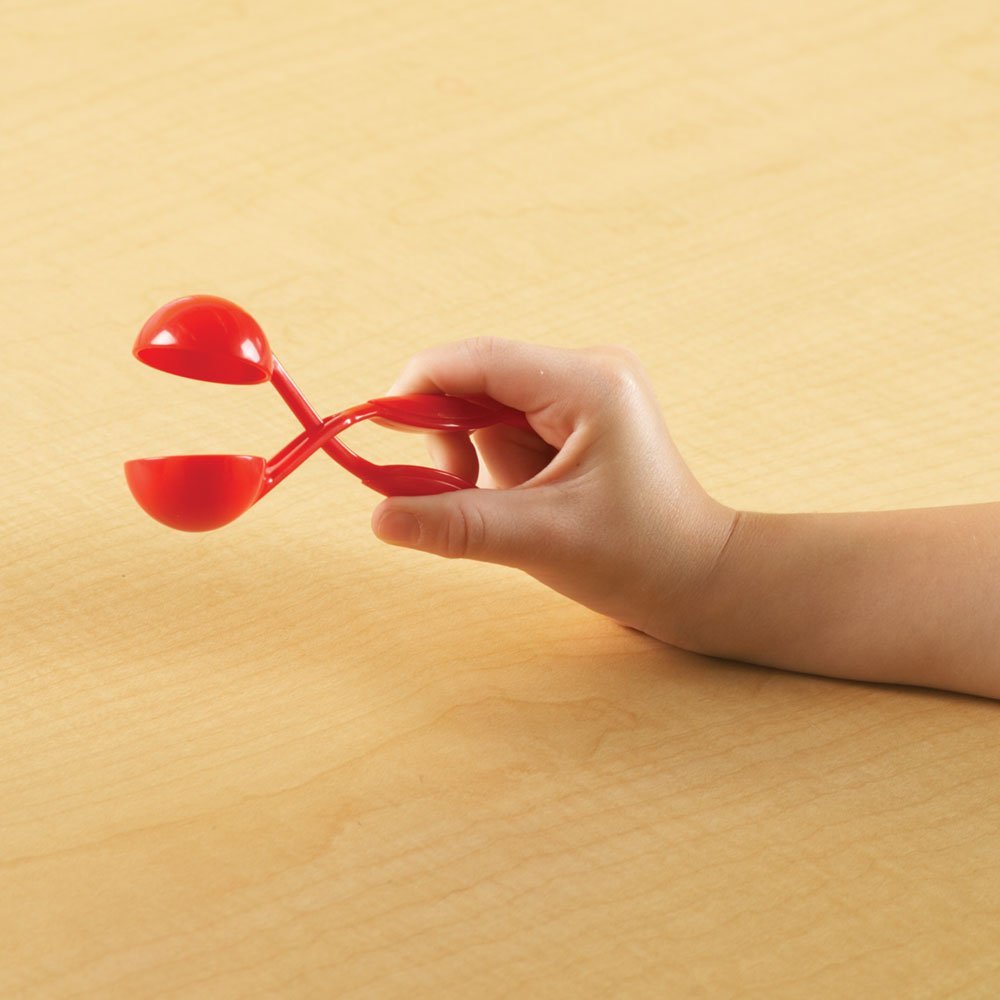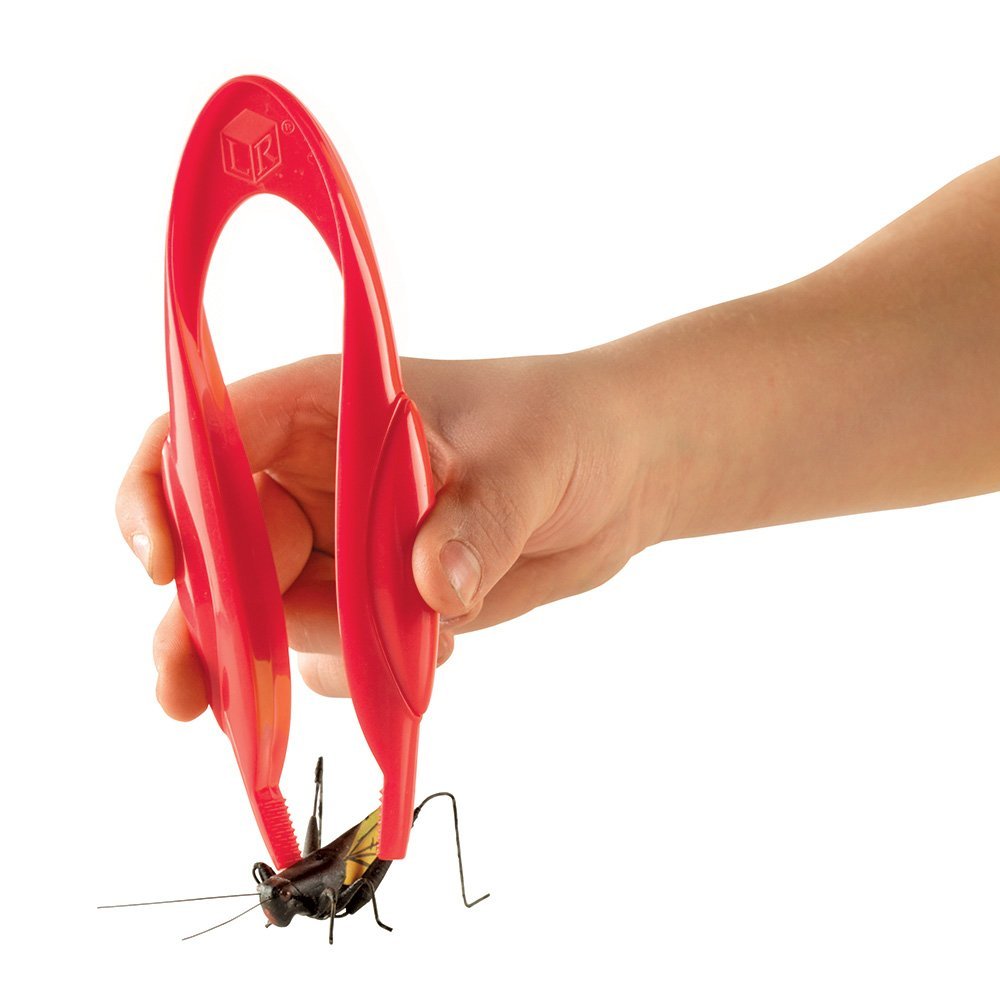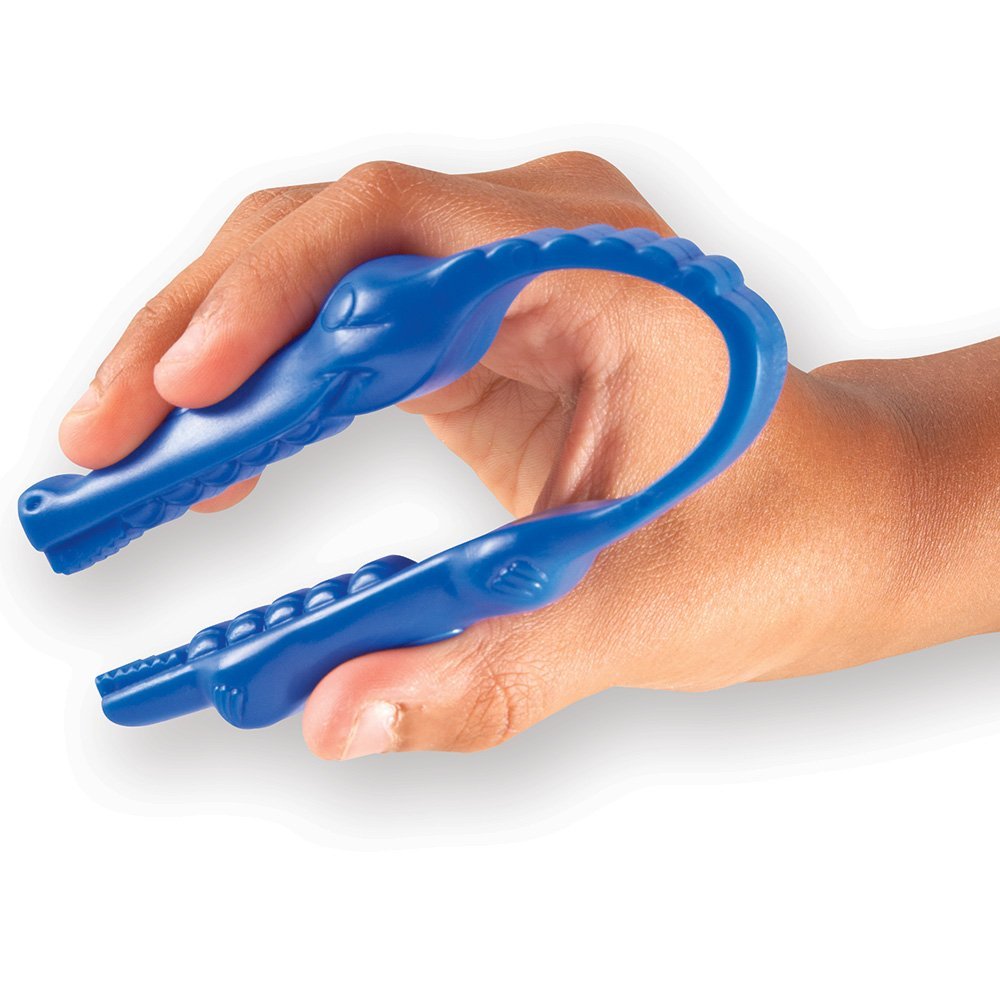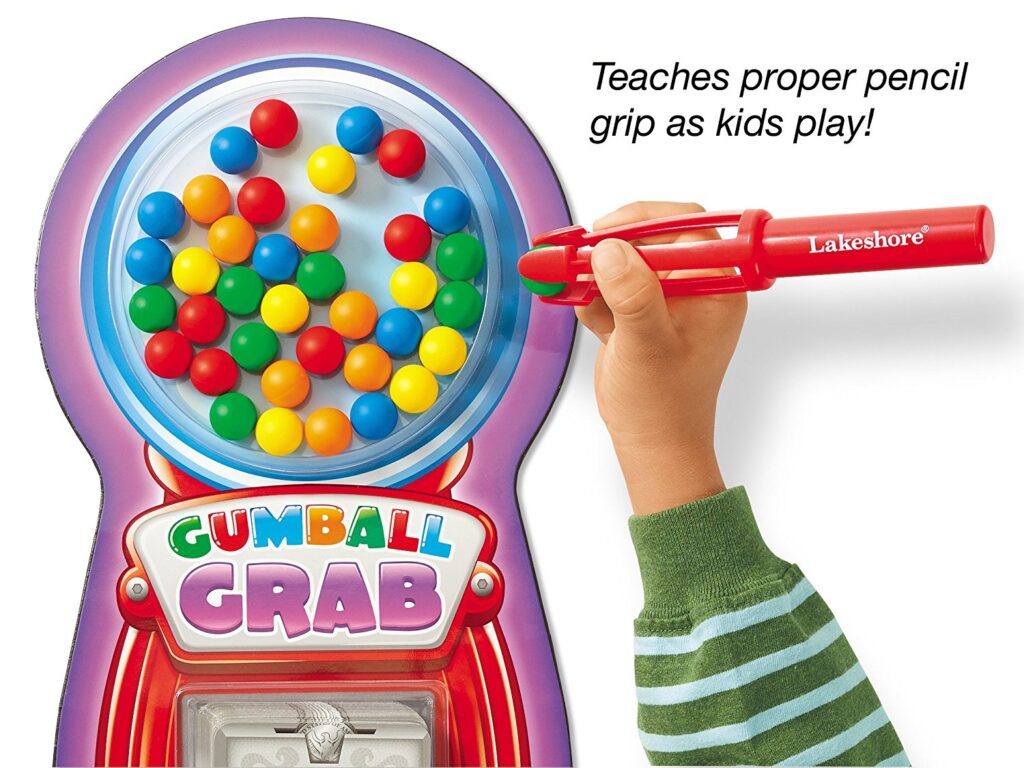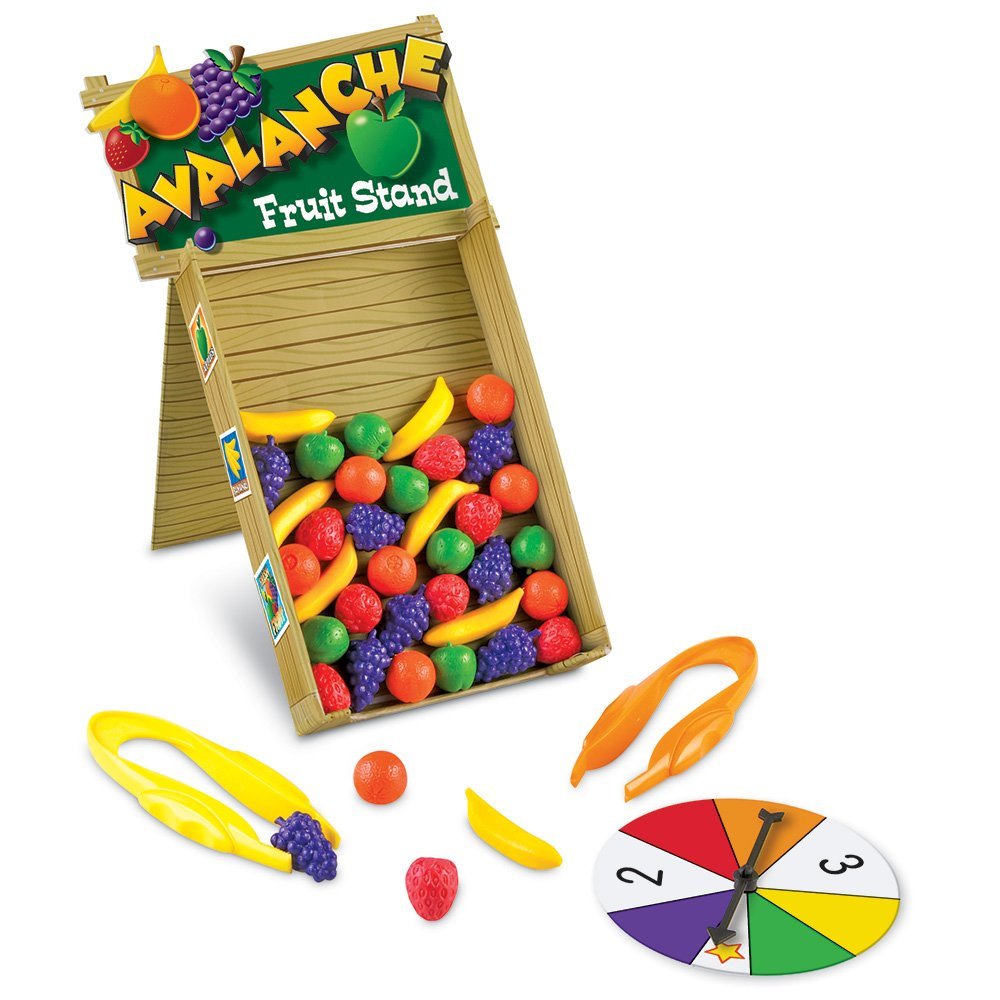One of the most popular posts here on The OT Toolbox is our 31 Days of Occupational Therapy Activities. It was a couple of years back that we shared 31 different occupational therapy activities using free or inexpensive materials. Since then, so many of you have checked out that list of activities. I wanted to expand on that series and add to your therapy toolbox using items you probably already have in your therapy bag. For that reason, we’ll be sharing lots more lists of therapy ideas using common items.
Today, we’ll be talking about occupational therapy activities using tongs.
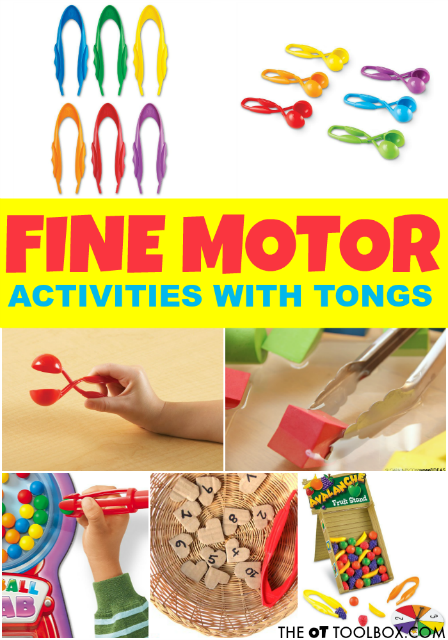
Occupational Therapy Activities Using Tongs
Most therapists probably have a pair of tongs in their therapy closet or therapy bag. There’s a reason why! Tongs are so very versatile when it comes to occupational therapy activities. They can be used in a variety of tasks and play activities that develop strength, an open thumb web space, bilateral coordination, crossing midline, shoulder and wrist stability, arch development, separation of the sides of the hand, visual motor skills, eye-hand coordination, direction-following, and SO much more!
Check out the activity ideas using tongs below for fresh ideas that can be used in treatment with many individuals.
These tong activities would be a great addition to summer occupational therapy activities and home programs!
Occupational Therapy Activities With Tongs
Use tongs to work on intrinsic hand strength and visual motor skills.
Make your own DIY Tongs with craft sticks! So fun and always a hit in our house.
Tongs can be helpful in increasing the graded grasp and release needed for controlling scissors when cutting. These bunny tongs were used to promote scissor skills.
Kids can work on eye-hand coordination with tongs. The nice thing about an activity like this one is that a variety of tongs can be used based on the child’s age, fine motor skills, development, or the goal of the activity.
Go small-scale and use a set of tweezers or mini tongs to remove seeds from apple slices.
Tongs can be added to an occupational therapy activity kit depending on the needs of children on a caseload. Use those tongs to address many different needs and underlying skills!
Incorporate tongs into play to address fine motor skills. Use the fine motor tool in a variety of play experiences.
Use mini erasers in counting, sorting, and learning like The Crafty OT.
Use tongs to manipulate and move strands of yarn in a pasta pretend play activity like Ever Never Again. What a fun activity!
Use cut straws and tongs to strengthen fine motor skills like Mess for Less.
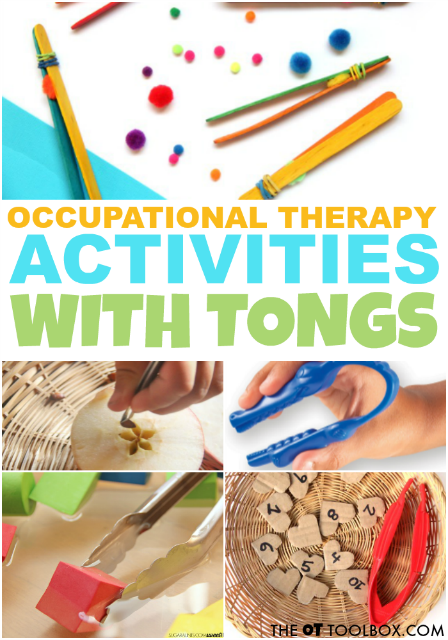
How can Occupational Therapy Activities Using Tongs Help with Development?
In SO many ways!Motoric Separation of the Two Sides of the Hands- Separation of the two sides of two sides of the hand is important for tasks like holding a pencil while stabilizing the hand along the table, cutting with scissors, and managing coins, among other activities. Refinement of fine motor skills in the hand (the radial side) happens when the power half (the ulnar side) is stabilized. A functional fine motor grasp and manipulation of objects is more accurate when the ring and pinky fingers are flexed (bent) into the palm. This positioning stabilizes the MCP arch and allows for control of the pointer and middle fingers. Separation of the two sides of the hand allow for more precise use of the thumb. Hand separation starts when a baby bears weight through their arm and ulnar side of the hand while carrying a toy in the radial side. This simple activity developmentally lengthens the muscles of the ulnar side. Hand Dominance-Hand dominance in children is important for refining the skills needed to perform functional tasks. While Toddlers begin to show a hand preference, a true hand dominance doesn’t typically develop until 2 to 3 1/2 years. A toddler can show a hand preference, however hand usage is many times, experimented with during different activities throughout the Toddler and Preschool years. There is typically variability in hand preference as toddlers and young preschoolers poke, pick up, throw, color, and play. Another consideration is that oftentimes, kids of this age are influenced in which hand they choose by position of toy, location of the adult or playmate, method materials are presented, and sitting position of the child. Lateralization refers to the brain’s ability to control the two sides of the body. Each hemisphere of the brain controls different tasks and functions. When a child shows difficulties with laterality, they might switch objects between the two hands in functional tasks. As a child grows, they are challenged to become more efficient with tools in school. True hand dominance may not be completely integrated in the child until around 8 or 9 years of age. Occupational therapy activities using tongs can help to build consistency with the child’s preferred hand dominance. If your child shows a preferred hand, set up the activity to work on tong use with the typically used hand. Open Thumb Web Space- An open thumb webspace is essential for true
opposition of the thumb to the precision side of the hand. A round “O” shape
allows the thumb to rotate and oppose the pointer finger in pincer grasp activities. When kids write or color with that web space area squashed shut, it’s a sign of problems. There may be compensation for thumb instability, underdeveloped hand arches, and/or poor strength. Each of these problem areas will lead to difficulties with handwriting, dexterity, manipulation of small items like beads, and pencil grasp. Activities using tongs can help with development of an open thumb web space. Precision of Grasp- Precision skills allow a person to manipulate and release of small objects. Precision provides efficient grading movements in very small dexterity patterns like threading a string through a needle. Difficulty with precise motor movements of the hand may cause fumbling with zippers and buttons and trouble with advancing the pencil on small lines of paper. Precision occurs with development of grasp when child to use the pads of the index finger, middle finger, and thumb to manipulate objects with opposition. Occupational therapists can promote precision of grasp with activities using tongs in occupational therapy activities. Pinch Strength and Control- There are a few different grip postions of the
hand and fingers that are used in play with children. Difficulties in using and
maintaining any certain grasp may interfere with tasks that require using the
hands. Types of grasp patterns that can be addressed using tongs include:
- Lateral Pinch Grip (aka Key Pinch Grip)- The thumb opposes the lateral side of the pointer finger. This grasp is used when holding and and using a key. A sub group of this type of pinch is the Lateral Prehension Grip– The thumb is flexed (bent) and it’s pad opposes the lateral side of the tip of the pointer finger. This grip is used to hold an index card or paper, sometimes.
- Three jaw Chuck Pinch Grip– The thumb is flexed (bent) and opposes the pads of the pointer finger and middle finger. Holding a small cap like a toothpaste lid uses this grip. This is the grip used in holding a pencil.
- Tip to Tip Grip– The tip of the thumb touches the tip of the pointer finger. The thumb and pointer finger form an circle (or open thumb web space). This grasp is also called a pincer grasp. It is used to pick up small items like cereal or beads. If very small items are picked up (like a needle), a Neat Pincer Grasp is being used.
- Lateral Grip– Pinching an item between the pointer and middle fingers use this grip. You would use this grip in holding a cigarette. While this is not a functional grasp for kids (obviously), you might see kiddos fiddle with a pencil by holding it between two fingers.
Gross Hand Strength and Grasp- Gross grasp is used when squeezing all of the fingers shut around an object, like when holding the handle of a suitcase. Gross grasp is important in tasks like handwriting and scissor use. To do these activities, you need to squeeze your whole hand shut and maintain endurance to complete the activity. Development of hand arch and thumb web space is important for these functional skills and gross grasp plays a part. Occupational therapy activities using tongs can address hand strength by increasing repetitions or smaller object manipulation with a variety of tongs. Thump Opposition- Thumb oppositon occurs when the thumb is rotated at the
carpometacarpal joint. Opposition of the thumb to the fingertips is essential
for tasks such as holding a hairbrush, managing buttons, and even grasping a door
knob. Thumb opposition coincides with an open web space in functional tasks. Tongs can be used to address thumb opposition by ensuring rotation of the base of the thumb and curving of the palmar arches. Occupational therapy activities using tongs can promote these skills. Palmer Arches- In the palm of the hand, there are arches that shape the hand’s grasp on
objects of all shapes and sizes. There are two transverse arches that cross the hand at the
carpals and at the metacarpals. There is a longitudinal arch for each finger. These arches
allow for skilled movements of the hands and first develop during crawling. Arch development
is essential for manipulating small objects such as a writing utensil. Bilateral Coordination- Bilateral coordination is the functional use of the two hands
together in a coordinated manner. It’s coordinating both hands together and is closely related
to hand dominance. When a child has an established hand dominance, there needs to be a
fluid use of the two hands together. In development of the child, children use both hands together then progress to using one hand at a time and finally using both hands together.
Refined bilateral coordination skills allow a child to use both hands in separate tasks fluidly. Use tongs to promote bilateral coordination by asing kids to support a bowl or cup while manipulating or moving small items with tongs with the dominant hand. Wrist and Hand Development- A prerequisite to controlled movements of the hand and
fingers are strength and stabilization of the wrist. Control in the wrist allows for
manipulation of small items and grasps with the fingers. A functional position for the wrist in most activities requiring fine motor skills is slight extension and neutral positioning.
This is an optimal position for handwriting or tasks such as manipulating tongs.
Other activities like using a toothbrush or managing a utensil during feeding require
slight ulnar deviation. Stabilization of the wrist is essential in play and learning activities.
In order to allow precision of fine motor tasks, the wrist should be stabilized in extension
with precision tasks performed on a vertical surface, putting the wrist into optimal
positioning and facilitating thumb abduction for distal work to the fingers.
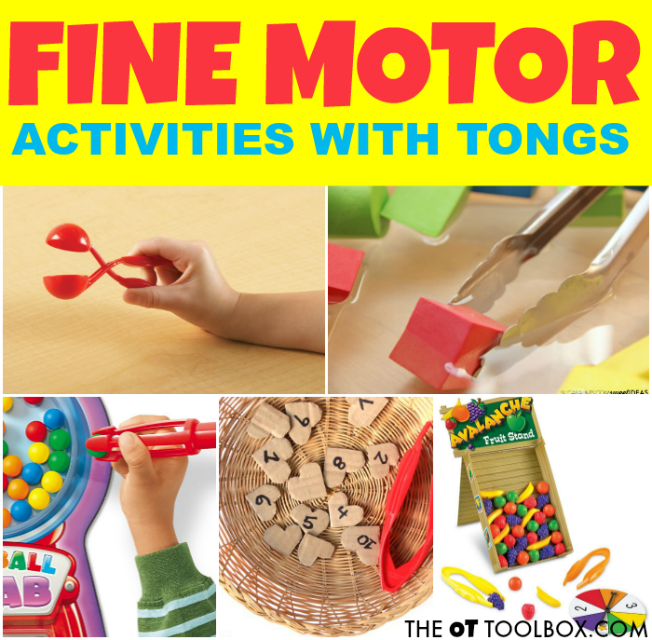
Best tongs for promoting fine motor skills in Occupational Therapy Activities
Occupational Therapy Activities Using Tong Games
